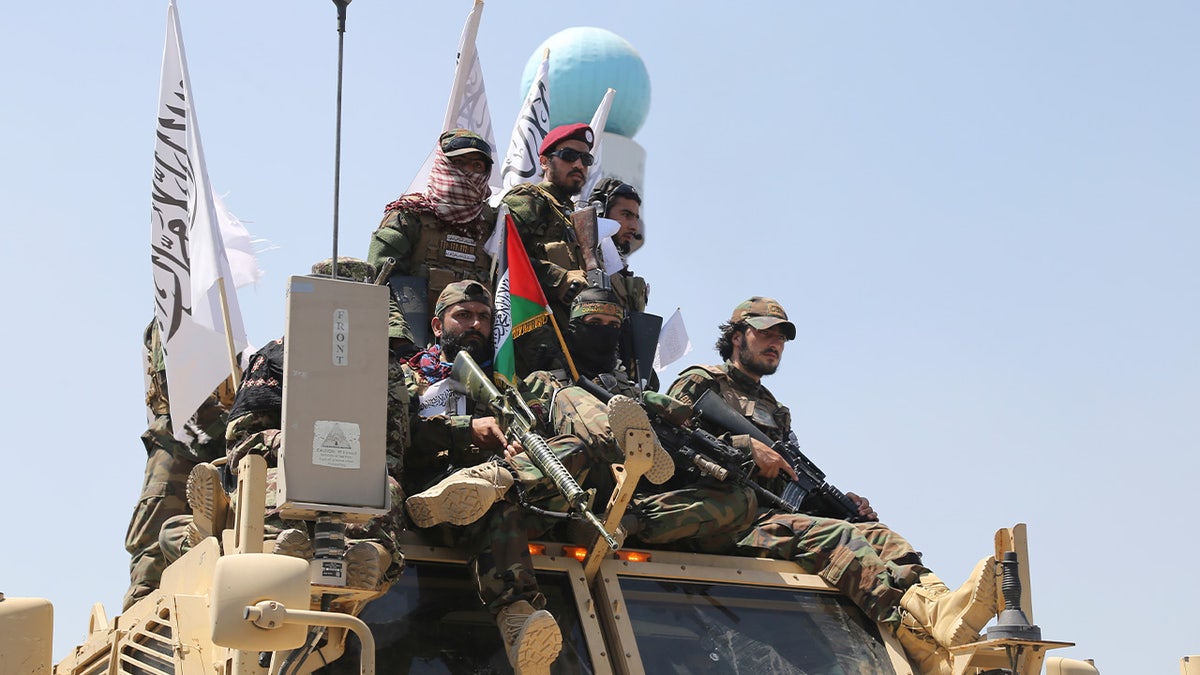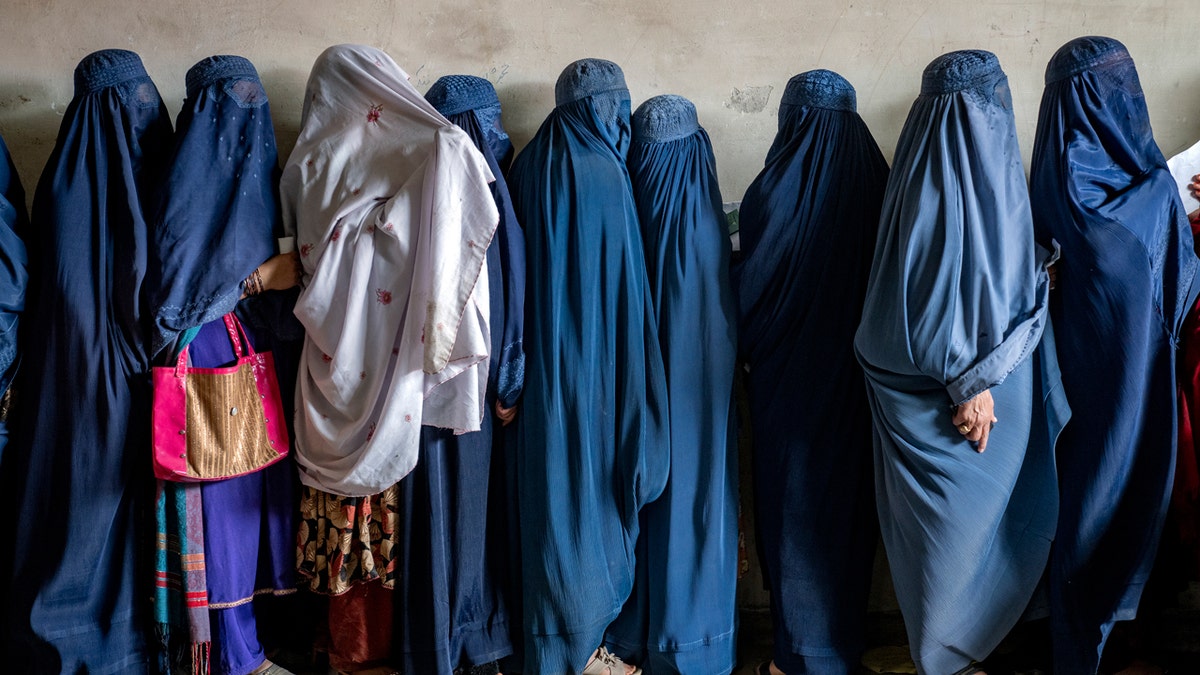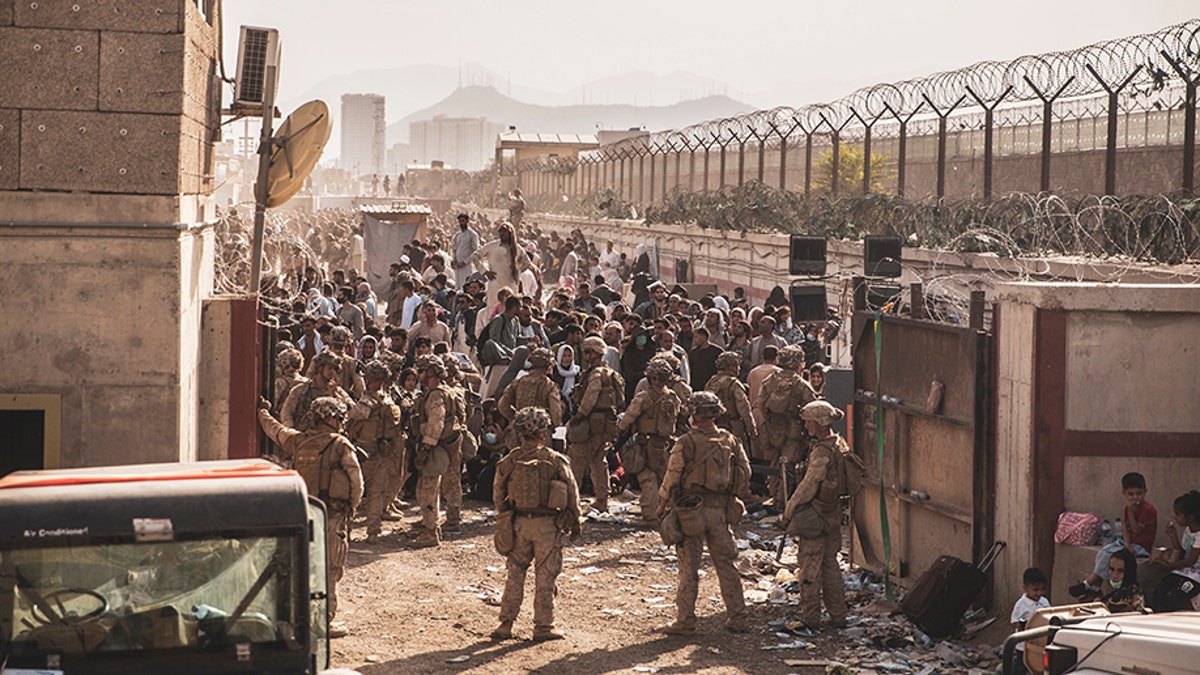Rep. Mike McCaul, a Republican from Texas who chairs the House Foreign Affairs Committee, released a scathing report taking a hard look at the failure to withdraw troops from Afghanistan in 2021 and highlighting areas of serious mismanagement.
The Republican-led report begins by recalling President Joe Biden's rush to withdraw from the Vietnam War as a senator in the 1970s, which, along with the withdrawal from Afghanistan, shows “a pattern of dispassionate foreign policy positions and a willingness to abandon strategic partners,” according to the report.
The report also disputed Biden's assertion that he was bound by the Doha agreement that former President Trump struck with the Taliban, which set a summer 2021 deadline for the withdrawal of U.S. troops, and made clear that administration officials had no plans to withdraw Americans and allies while troops were still there to protect them.
A U.S. Marine holds up an infant through a barbed wire fence during an evacuation at then-Hamid Karzai International Airport in Kabul, Aug. 19, 2021. (Omar Haidiri/AFP via Getty Images)
Below are summary findings from the 350+ page report, which is comprised of tens of thousands of pages of documents and senior interviews spanning the better part of the past two years.
Biden was not bound by the deadline of Trump's Doha agreement with the Taliban.
According to the report, President Biden and Vice President Harris had received advice from top leaders that the Taliban had already violated the terms of the Doha agreement and therefore the United States was under no obligation to withdraw.
House committee subpoenas Blinken over Afghanistan withdrawal
The committee also noted that NATO allies had voiced strong opposition to the US decision to withdraw, with the British Chief of Defence Staff warning that “a withdrawal under these circumstances would be seen as a strategic victory for the Taliban.”
Biden retained Zalmay Khalilzad, the Trump appointee who negotiated the deal, as special envoy for Afghanistan, signaling the new administration's endorsement of the agreement.
At the Taliban's demand, Khalilzad excluded the Afghan government from the talks, a major blow to the government of President Ashraf Ghani.
When Trump left office, there were about 2,500 U.S. troops left in Afghanistan. Biden himself was determined to get that number to zero no matter what, Col. Seth Krumrich, chief of staff of Special Operations Command, told the committee. “The president has made the decision to withdraw, and he's not listening to anybody.”
Then-State Department spokesman Ned Price acknowledged in his testimony that the Doha agreement was “irrelevant” to Biden's decision to withdraw.

Taliban fighters celebrated the third anniversary of the U.S.-led withdrawal from Afghanistan in Kabul last month. (AP Photo/Sidiqullah Alizai)
Withdrawal: State Department reinforced personnel but was unable to develop an exit plan as it became clear Kabul would fall.
The report also details how the State Department received numerous warning signs urging it to reduce the size of the embassy as it became clear that Afghanistan would soon fall to the Taliban. The State Department refused. At the time of its withdrawal, the embassy was one of the largest in the world.
In the end, troops were ordered to withdraw before the embassy was closed, leaving Americans and their allies behind.
At one meeting, Brian McKeon, deputy secretary of state for management and resources, said, “We at the State Department have a much higher risk tolerance than you do,” denying military officials' warnings.
Gen. Austin Miller, Afghanistan's longest serving commander, confirmed McKeon's comments, explaining that the State Department did not show a high tolerance for risk but rather a “lack of understanding of the risks” in Afghanistan.
Asked why McKeon made such a statement, the official explained: “The State Department and the president were saying it, and as a result (Wilson) and others started saying it because they thought it would work.”
The report criticizes former Afghanistan ambassador Ross Wilson for expanding the embassy's size rather than shrinking it as the security situation worsened.
Wilson, with little sense of urgency, took two weeks off in the last week of July and the first week of August 2021.

The Taliban's Ministry of Virtue announced on May 7, 2022 that women must wear full-body robes and cover their faces except for their eyes in public. (AP Photo/Ebrahim Norouj)
The order for a non-combatant evacuation operation (NEO) was not given until August 15, as the Taliban advanced on Kabul.
Because there were not enough troops to begin NEO until August 19, the first official message urging Americans to evacuate was sent from the embassy in Kabul on August 7.
There were not enough military aircraft available to handle the evacuation, so it took until August 20 for the Ministry of Transportation to authorize foreign air support.
According to the report, Wilson fled the embassy before the entire staff, and was reportedly infected with COVID-19 at the time, but had diplomats get him tested so he could leave the country.
Acting Undersecretary Carol Perez told the committee that despite months of warnings, plans to evacuate the embassy were “still in the works” when the Taliban took control.
People left behind: Americans and allies turned away, Afghans board planes unscreened
Wilson testified that he was “content” with postponing the NEO until August 15, but Gen. Frank McKenzie described it as “the fatal flaw that caused what happened in August.”
When the Taliban besieged Kabul on August 14, records of a National Security Advisor (NSC) meeting obtained by the committee revealed that the U.S. government had still not decided who would be eligible for evacuation, nor had it identified any third countries through which the evacuees could pass.
In the months of June, July, and August prior to the seizure, the number of Special Immigrant Visas (SIVs) granted to evacuate U.S.-allied forces in Afghanistan, including translators, was lower than in the four months prior.
When the last U.S. military plane left Kabul, approximately 1,000 Americans were left on the ground, along with more than 90 percent of Afghans eligible for SIV benefits.
According to the report, local embassy staff were deprioritized for evacuation and were turned away from the embassy and airports, many in tears. On the day the Taliban took power, the only U.S. guidance for those potentially eligible for evacuation was to “not go to the airport until you have been notified by email that exit options are available.”
The NSC also did not send guidelines on who was eligible for evacuation or who should be prioritized because they were “at risk,” leading the State Department to process thousands of evacuees without documentation.
A State Department official told the committee that the U.S. government “had no knowledge whether the people being evacuated posed a threat.”
After the last troops left Afghanistan, volunteer groups helped at least 314 U.S. citizens and 266 legal permanent residents leave the country.
Abbey Gate scene: terror threat warnings ignored before the bombing
And while the Taliban flogged crowds of desperate Afghans at airports, burned young women to death, and executed civilians, U.S. troops were barred from intervening.
Consul General Jim DeHart described the scene as “apocalyptic.”
Meanwhile, U.S. intelligence agencies were tracking multiple threat streams by August 23, including “potential VBIEDs or suicide vest IEDs as part of a combined attack.” By August 26, the threat was narrowed down to Abbey Gate. The threat was so severe that diplomatic security officials withdrew state personnel from the gate.
Brigadier General Farrell Sullivan, at the urging of the British, ultimately decided to leave the gates open in the face of the threat.
Afghan general says country has again become 'crucible of terror'
Then, on August 26, two bombs planted by the terrorist group ISIS-K exploded at the airport, killing 13 U.S. soldiers and more than 150 Afghans. CENTCOM records revealed that the same ISIS-K terrorist group that carried out the Abbey Gate attack “established an operating base six kilometers west of the airport” in December 2020, in an area the group had previously used as a staging area for airport attacks. However, the U.S. had not attacked the group prior to the bombings.
Two weeks later, 10 civilians were killed in an airstrike meant to kill those behind ISIS-K. The regime initially touted the strike as a success of its transatlantic airstrike capabilities, but later acknowledged that civilian families had been killed.
The U.S. has not struck ISIS-K in Afghanistan since then, a stark contrast to the 313 operations CENTCOM conducted against ISIS in Iraq and Syria in 2022.

U.S. soldiers are supporting the State Department with non-combatant evacuation operations in Afghanistan. (Department of Defense)
Long-term effects
In addition to the $7 billion worth of US weapons that were abandoned, the Taliban may have accessed up to $57 million in US funds originally provided to the Afghan government.
Taliban Interior Minister Sirajuddin Haqqani declared in February 2024 that relations with the rest of the world, particularly the United States, were “irrelevant” to Taliban policymaking.
A NATO report prepared by the Enhanced Defense Education Program found that the Taliban had used U.S. military biometric devices and databases to track America's Afghan allies.
The report also said that in the six months since the Taliban came to power, “approximately 500 former senior Afghan government officials and members of the security forces have been killed or forcibly disappeared.”
Click here to get the FOX News app
Some 118 girls have been sold into child marriage since the government took power, with 116 more families waiting to buy them. The women are now banned from speaking or showing their faces in public.
In June 2024, the Department of Homeland Security identified over 400 suspects of Central Asian origin who illegally crossed the U.S. southern border with the aid of an ISIS-linked smuggling network. The U.S. has subsequently arrested over 150 of these individuals. On June 11, 2024, the FBI arrested eight individuals with ties to ISIS-K who crossed the southern border.

